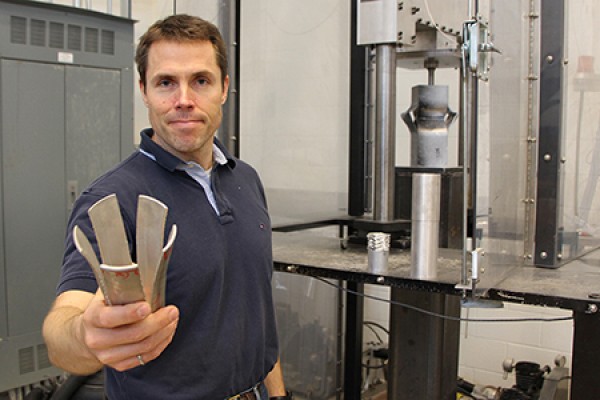 Engineering professor Bill Altenhof is an organizer of the International Crashworthiness Symposium, to be held on the UWindsor campus April 11.
Engineering professor Bill Altenhof is an organizer of the International Crashworthiness Symposium, to be held on the UWindsor campus April 11.
Automotive engineers from around the world will come to UWindsor next month for the International Crashworthiness Symposium to discuss the design of lighter-weight vehicles and cutting-edge innovations to improve fuel efficiency and vehicle safety. The symposium also sets the stage for UWindsor to sign the Cooperation Agreement on Novel Lightweight Technologies for Improved Crash Safety, along with the University of Waterloo and the German Aerospace Centre.
“This is an opportunity for researchers from academia and industry to get together and showcase both their efforts and commitments towards vehicle light weighting,” says Bill Altenhof, professor of Mechanical, Automotive and Materials Engineering and an organizer of the symposium. “We’ve had an impressive response and interest from automakers and their suppliers.”
Dr. Altenhof says the event is also the dawn of a new partnership that will see Canadian academics and German industry experts working together to find new ways of using lightweight materials for crash safety.
“The focus of the agreement is about collaborating and developing novel ways to dissipate energy in a crash, for the protection of people within vehicles,” he says. “We are trying to think outside the box and apply innovative techniques to re-work traditional designs to bring vehicle structural crashworthiness to a new level of performance.”
Altenhof and his graduate students have found that working with such lighter-weight metals as magnesium to be challenging because when involved in a crash, they can split, deform and fracture in ways that steels and aluminum alloys do not.
The research team cuts channels in the metal, which act as an energy absorber, with the resulting system having a consistent and predictable crash behaviour.
“Using some of our recently patented technologies, we can adjust aspects of the system to engineer a particular response for a specific vehicle requirement,” he says.
He says these new designs have the ability to ‘wisely’ distribute loads in a vehicle structure and dissipate energy, in low and even in high speed crashes, preventing excess energy from being transferred to vehicle occupants.
Traditional vehicle parts made with heavier materials will fold when crushed resulting in load fluctuations with the formation of every fold.
“If you can mitigate or eliminate load oscillations during the crash event that is a big benefit for the design and occupants in the crash.”
The symposium will include presentations by academic and industry experts, including UWindsor PhD candidate Matt Bondy, who will present findings from his research efforts on the Impct loading of long fibre technology carbon fibre/nylon composites.
“When you are in a severe accident, your life, and many of those close to you, will change forever. With the economic burden of automobile crashes in North America in the billions of dollars per year, any contribution we can make has the potential to save so many lives and millions of dollars,” Altenhof says.
Registration is mandatory for the free event which takes place on Monday, April 11, in the Centre for Engineering Innovation. For more information, phone 519-253-3000, ext. 2619, or e-mail crash@uwindsor.ca.
